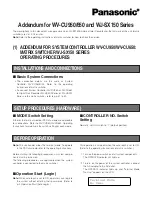
101
10.1 HDCP
10. APPLICATIONS NOTE AND TIPS
HDCP is a content protection mechanism which uses encrpytion to prevent high value content from being
delivered to non-authorized devices. For example, Blu-ray players use HDCP on their HDMI outputs to ensure
that the HDMI output cannot be routed to a digital recording device.
The
Eikos²
is fully HDCP compliant, meaning that you will be able to use the
Eikos²
to accept HDCP protected
sources and route them to any HDCP protected outputs. As Analog Way is a licenced HDCP adoptor, this also
means that the
Eikos²
is prevented from displaying any HDCP protected images on any non-HDCP compliant
outputs (as is the case for all licenced HDCP compliant devices).
HDCP can only be used on certain connection formats, including DVI, HDMI, and Displayport. Keep in mind
that simply because a connection is using a DVI, HDMI, or Displayport connection, it does not guarentee
that the devices connected are maintaining an active HDCP connection. For example, you may find video
recording or capture devices equipped with an HDMI input, however HDCP licencing forbids these devices
from capturing HDCP protected content.
HDCP is not supported on connection formats such as composite, component, Svideo, SD-SDI, HD-SDI,
3G-SDI, or VGA. This means that any source which becomes protected by HDCP cannot be converted to
these formats. For example, while you may find a Blu-ray player which can directly output a composite video
signal, HDCP licencing forbids converting the HDCP protected HDMI signal back to composite or any other
non-protected format.
To help troubleshoot HDCP in your installation, each input and output page is equiped with HDCP status
information to indicate in realtime when HDCP encryption is being used.
Certain devices such as Macintosh computers can be misleading to use in conjunction with an HDCP
compliant presentation switcher such as the
Eikos²
. This is because devices like the Mac computers can be
used to output both HDCP protected content (such as a movie downloaded from iTunes) as well as non-
HDCP protected content (such as a Keynote presentation or the desktop). When a computer first connects
to an HDCP compliant device such as the
Eikos²
, it learns the capabilities of the device through the EDID
connection. Upon seeing the HDCP compatibility of the attached
Eikos²
, devices like the Mac computers will
immediately attempt to use HDCP encrpytion at all times, despite the content currently displayed on the
computer screen. Since this source would now be considered an HDCP protected source, the
Eikos²
would
be required to prevent it from being displayed on VGA or SDI outputs and only allow it to be displayed on
outputs protected by HDCP. To work around this problem, the
Eikos²
allows the HDCP features of a particular
input to be disabled, which in turn informs the Mac computer to avoid using HDCP, and allows content such
as Keynote and the desktop to be displayed, as this input will no longer use HDCP protection. Please note
that disabling the HDCP features of the input do not circumvent HDCP protections, and thus do not allow you
to view any content which requires this protection.
For more information about HDCP, please refer to our whitepapers on HDCP, or visit the HDCP foundation
website.
10.1
HDCP
Содержание Eikos
Страница 1: ...Eikos Ref EKS550 USER MANUAL...
Страница 2: ......
Страница 105: ......
Страница 106: ...Pictures and drawings non contractual Specifications subject to change without prior notice EKS550 12 30 2013 Follow us...






































